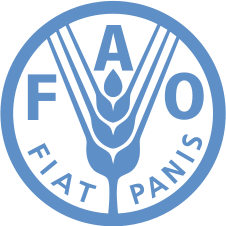 Know your marine environment and its ecosystems! This is the motto of a new collaboration between the Food and Agriculture Organization of the United Nations and Mundus maris. FAO entrusted Mundus maris with providing support for the implementation of communication activities for promoting the sustainable use of marine ecosystems in two pilot countries in West Africa (Senegal and The Gambia).
Know your marine environment and its ecosystems! This is the motto of a new collaboration between the Food and Agriculture Organization of the United Nations and Mundus maris. FAO entrusted Mundus maris with providing support for the implementation of communication activities for promoting the sustainable use of marine ecosystems in two pilot countries in West Africa (Senegal and The Gambia).
The letter of agreement defining the services agreed upon is established in the framework of the EAF Nansen project “Strengthening the Knowledge Base for and Implementing an Ecosystem Approach to Marine Fisheries in Developing Countries” (GCP/INT/003/NOR).
The agreement became effective 21 July 2011 and entails four parts: (1) a needs assessment, (2) a strategy to define the pilot activities, (3) the implementation of the pilot activities and (4) the analysis and reporting of experiences and results.
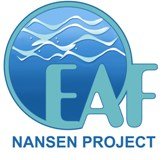 As part of the needs assessment, we interviewed school teachers and stakeholders from coastal areas in Senegal and The Gambia to find out more about the current teaching on marine ecosystems, what teaching methods are used - both 'traditional' and 'modern'. We also looked into what other communication means people of different age groups use to inform themselves and communicate.
As part of the needs assessment, we interviewed school teachers and stakeholders from coastal areas in Senegal and The Gambia to find out more about the current teaching on marine ecosystems, what teaching methods are used - both 'traditional' and 'modern'. We also looked into what other communication means people of different age groups use to inform themselves and communicate.
The purpose of this pilot study is to find out, what are the communication needs of children particularly in coastal areas of the two countries to learn more about the marine ecosystems at their doorsteps. This study should lead to developing activities in this direction. As usual, we'll build on what's there already and will seek cooperation. There are a good number of reliable resources that we can build on and put to good use. Let's just mention a few.
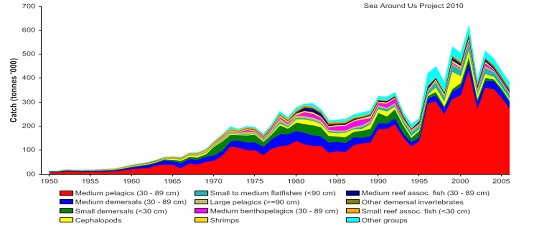 What do we know about marine ecosystems in Senegal, Gambia and other countries in NW Africa? Patient research over decades has pieced together useful qualitative and quantitative information even though there are still big holes in our knowledge and understanding.
What do we know about marine ecosystems in Senegal, Gambia and other countries in NW Africa? Patient research over decades has pieced together useful qualitative and quantitative information even though there are still big holes in our knowledge and understanding.
Taking Senegal as an example, the graph shows the ups and recently more downs of marine landings as they have been reconstructed by the Sea Around Us Project led by Daniel Pauly. This is based on official catch statistics and any corrections applied based on independent sources and triangulation.
FishBase, the global web archive on all fishes provides species lists by country. Behind each name is an information sheet about key characteristics of the species, its distribution, growth, food, a picture and much more. There are many other ways to extract useful information from the huge pool depending on the need. Identification keys help to put a name of an unknown species and a fish quizz is loved particularly by kids. SealifeBase works towards developing such information for all non-fish species in the oceans.
The continuous process of change in fishing strategies, including the rise of illegal, unregulated and unreported (IUU) fishing, markets and other drivers of change (coastal construction, erosion, pollution, climate, marine protected areas and other conservation measures...) has an impact on the functioning and productivity of ecosystems, even if there is insufficient capacity to monitor all of them systematically. The composition of landings reflects these changes. Many valuable species in the ecosystem are fully exploited or overexploited and have become rarer in the landings. This now also impacts on the earnings of the fishermen and the men and women active in the postharvest sector (handling, processing and marketing), even though we know that healthy ecosystems can produce more on a sustainable basis.
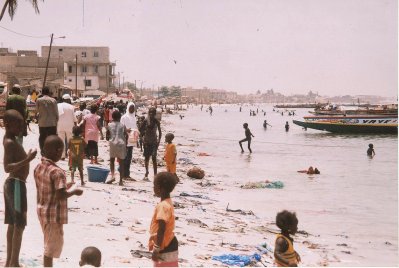 So, we have interviewed teachers and principals of 22 primary schools and 13 secondary schools in Senegal and The Gambia throughout August 2011. These schools were in the coastal fishing towns of Saint Louis, Kayar, Hann, Mbour and Ziguinchor in Senegal and Brufut, Tanji and Gunjur in The Gambia and between them have more than 20,000 pupils. We also asked many other stakeholders in the communities for their views and experiences, in total some 80 people.
So, we have interviewed teachers and principals of 22 primary schools and 13 secondary schools in Senegal and The Gambia throughout August 2011. These schools were in the coastal fishing towns of Saint Louis, Kayar, Hann, Mbour and Ziguinchor in Senegal and Brufut, Tanji and Gunjur in The Gambia and between them have more than 20,000 pupils. We also asked many other stakeholders in the communities for their views and experiences, in total some 80 people.
There is already some interesting past experiences in some of the towns of directing school projects at local environmental problems as is illustrated by an example of the Khadim School in Hann.
The project involved classroom-based teaching (e.g. as shown here in relation to different recycling times of different types of wastes and how long they may remain polluting the coastal and marine environment.
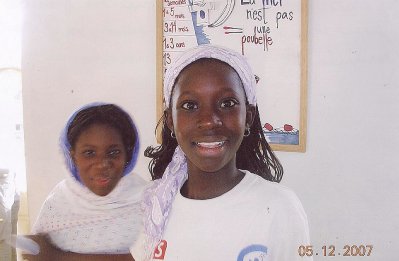 This teaching was successfully combined with excursions and theatre around themes chosen by the pupils themselves. From the survey of schools it emerged, however, that introduction to knowledge about marine ecosystem is confined to special projects, not part of the standard curriculum.
This teaching was successfully combined with excursions and theatre around themes chosen by the pupils themselves. From the survey of schools it emerged, however, that introduction to knowledge about marine ecosystem is confined to special projects, not part of the standard curriculum.
What also emerged is that many schools have large class sizes and few means to support the teaching.
As a result, not all children complete school successfully. In some towns, NGOs, ministries and others supporting environmental awareness, conservation and rebuilding also have outreach activities to schools and the general public, but this is not generalised.
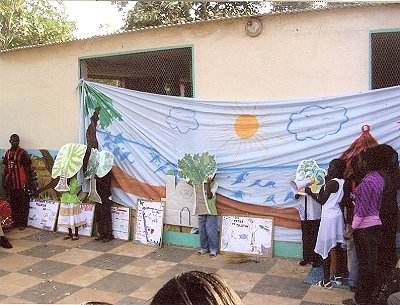 The need for visual supports and teaching aids came out strongly among the needs in relation to enhancing awareness and knowledge about marine ecosystems. Teachers would welcome films, posters, and other such means as they have noted best learning results, whenever these were available.
The need for visual supports and teaching aids came out strongly among the needs in relation to enhancing awareness and knowledge about marine ecosystems. Teachers would welcome films, posters, and other such means as they have noted best learning results, whenever these were available.
Radio transmissions of a number of stations now operating at local and national levels are already used by many NGOs for conveying their messages in support of marine protected areas and other issues. In Senegal and Gambia traditional culture continues to play an important role in learning and communication. Among these, theatre and market cryers (griots), dance and sport competitions are the most prominent.
Luckily the Regional Programme on Environmental Education in West Africa supported by IUCN, WWF, FIBA, the Sub-Regional Fisheries Commission (CSRP) and Wetlands International has very recently put out an excellent booklet about marine and coastal ecosystems of the subregion.
This should be an important component in the efforts of responding to the communication needs of teachers, children and other interested people. It already exists in three languages: English, French and Portuguese.
The international NGOs actively working on protecting the marine environment provide some useful web resources. FAO has published a technical report about existing marine protected areas (MPA) in developing countries and their governance (including case studies from West Africa).
Then there is the generic guidance provided e.g. by the FAO guidelines on how to implement the Code of conduct for responsible fisheries, the application of which remains a challenge.
In a short while we hope to be able to suggest some practical follow-up when the schools are into the new term.
From the needs assessment to action
Of the total of 35 schools in Senegal and The Gambia (15 primary and 11 secondary schools in Senegal and 7 primary and 2 secondary schools in The Gambia), which participated in the needs assessment survey, nine have confirmed their interest to participate in pilot activities.
-
Primary School Kayar 1 (Senegal)
-
Ecole primaire de Hann Montagne (Senegal)
-
Immaculate Lower Basic School, Gunjur (The Gambia)
-
Tanji Lower Basic School (The Gambia)
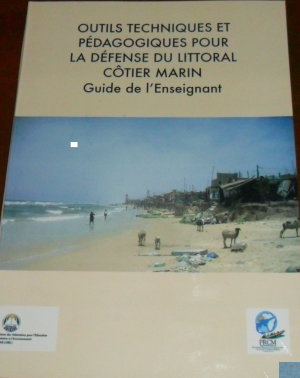 The preparations of the pilot activities are in full swing, actively involving local partners.
The preparations of the pilot activities are in full swing, actively involving local partners.
In Senegal, the Union of Volunteers in relation to Environment Education (UNI.V.ERE - l’Union des Volontaires de l’Education Relative à l’Environnement) is an NGO working on the promotion of environmental issues in the national curriculum.
Two founding members are Gora Kane, retired school system inspector and president of UNI.V.ERE, and Seydou Sow, the Director General of “Nouvelles Editions Africaines du Sénégal”. They have already developed a teaching aid to support teachers' work on environment themes.
The teaching aid has been prepared in the context of the regional IUCN project on environmental education and will help to use the IUCN knowledge handbook “Discovering the coastal and marine environment in West Africa” effectively in schools.
The two leaders of UNI.V.ERE are understandably keen to see some practical trials carried out using the existing educational materials and additional ones under preparation by this Mundus maris project.
Having such experienced partners engage with the pilot activities is expected to support quality in design, implementation and evaluation.
In The Gambia, Stay Green Foundation (SGF) is a recognised NGO, particularly active in environment protection on the North Bank of the country. SGF is headed by Baboucarr Mbye, who has extensive experience in training the trainers on environmental matters combined with gender and wider social equity concerns. SGF is a regular collaborator with IUCN and has in turn some female teachers working more particularly in the coastal zone from Banjul to Gunjur, particularly Therese Jatta et Fatou Duti Jatta.
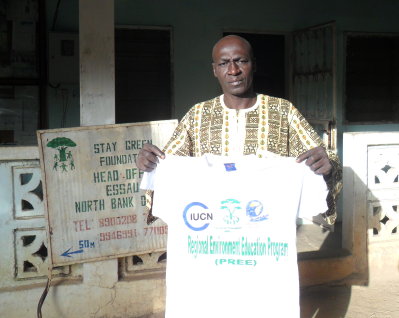 The Director of the Serekunda Primary School, Bolong Turay, is having his hands full already with the management of his well-run school with some 4000 pupils. All the same, he welcomed the concept of the pilot activities and indicated his willingness to host the preparatory and evaluation workshops to get the teaching trials done in the first quarter of 2012.
The Director of the Serekunda Primary School, Bolong Turay, is having his hands full already with the management of his well-run school with some 4000 pupils. All the same, he welcomed the concept of the pilot activities and indicated his willingness to host the preparatory and evaluation workshops to get the teaching trials done in the first quarter of 2012.
- The period of December 2011 and January 2012 is being put to good use to put together teacher support kits composed of the IUCN knowledge handbook “Discovering the coastal and marine environment in West Africa”,
- Teaching aids, e.g. 'Outils techniques et pédagogiques pour la défense du littoral côtier marin' (Technical and pedagogical tools for the protection of the coastal marine environment) prepared by UNI.V.ERE.
- Additional guiding notes and visual aids (posters, fish rulers) prepared by Mundus maris.
Fish rulers are not entirely new to the region. Birane Samb, at the time a researcher at the Marine Research Centre (CRODT) in Dakar and partner in the INCOFISH international research collaboration about 'Reconciling multiple demands on coastal zones', had already prepared one a few years back. The fish ruler shows the image of major fish species, which are overfished already and indicates the minimum size at which the fish will have reproduced. If only larger specimens are caught, the population should be safe from collapse, even be able to rebuild and to sustain a productive fishery. The research project produced a routine on its website to help anybody interested to develop such fish rulers for their country or part of the sea. They have recently been promoted e.g. in Germany by the consumer protection agency in Hamburg and Peru through a collaboration between IMARPE, the national Fisheries Research Institute, and Mundus maris.
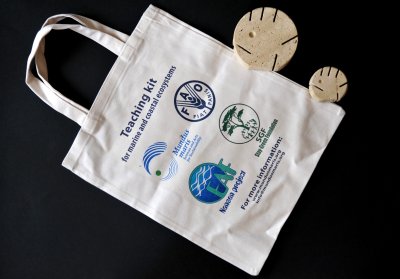 Experiences since the first exploration of fish rulers hold some lessons. The pioneers used the strict scientific definition of "length at first maturity", meaning the total length at which 50% of the population have reproduced (that means, the other half has not). As overfishing continues and stocks collapse, scientists now propose a minimum length at which 90 or 100% of the individuals in a fish population have reproduced at least once. If this were generally applied, stocks would not collapse anymore from overfishing and the total weight produced for human consumption would automatically be higher (bigger size = more fish to eat). In other words, it would be a win-win situation for all concerned, not only for the fishers themselves.
Experiences since the first exploration of fish rulers hold some lessons. The pioneers used the strict scientific definition of "length at first maturity", meaning the total length at which 50% of the population have reproduced (that means, the other half has not). As overfishing continues and stocks collapse, scientists now propose a minimum length at which 90 or 100% of the individuals in a fish population have reproduced at least once. If this were generally applied, stocks would not collapse anymore from overfishing and the total weight produced for human consumption would automatically be higher (bigger size = more fish to eat). In other words, it would be a win-win situation for all concerned, not only for the fishers themselves.
Implementation schedule
-
Between end January and mid February 2012 a two-day workshop will be convened in each of the two participating countries with two teachers from each school, a school inspector and resource persons from the local partner organisations together with the Mundus maris local coordinator, Aliou Sall. The aim is to present and critically discuss the pedagogical support kit, setting up a schedule for testing the pilot teaching modules and agreeing on a monitoring and evaluation scheme.
-
Between February and early March 2012 all test activities should be carried out in the participating schools and carefully monitored. Monitoring and evaluation (M&E) sheets will be used to collect experience from using the teaching aids in real life situations. M&E are particularly important to learn lessons for future use and possible updates of teaching aids and eventual their roll out.
-
Between early and late March 2012 a workshop will be convened in each country to review the experience and analyse lessons together for the future. Participants will be the same as in the first workshop.
-
The collective experience will be written up by Mundus maris in April 2012 and validated by participants in view of reporting back results and an outlook to FAO's EAF Nansen Project.
Mundus maris will also encourage use of free web resources, which can be accessed via internet. Among these is the global web archive on all fishes - FishBase. A fish quizz and other apps will shortly be available via mobile phones, which are more widely distributed than internet-connected computers.
Implementation schedule
The first two-day workshop with two teachers from each of the participating schools in Senegal was convened 17/18 February 2012 at the CEM in Hann-Pêcheurs.
Gora Kane guided the workshop as resource person from the local partner organisation, UNI.V.ERE, together with Aliou Sall, the local Mundus maris coordinator. The aim was to present and critically discuss the pedagogical support kit, setting up a schedule for testing the pilot teaching modules and agreeing on a monitoring and evaluation scheme.
The workshop started with introductory explanations about ecosystem concepts followed by a session on teaching approaches and available tools as provided by the project kit.
Much of the actual initial assessment work on the teaching aids was carried out in working group sessions. The picture gallery below captures some of the intense moments of critical analysis.
The strike movement in many Senegalese schools during this school year and the social movement in the run-up of the presidential elections (second turn on 25 March 2012) have slowed down the actual test work following the initial workshop. Instead of finalising these initial tests end March 2012, they are now rescheduled to be completed end April 2012.
A workshop with FAO staff will take stock of experiences so far based on the original needs assessment, the proposed communication strategy and the report about the teacher workshop in Senegal. It should set the stage for the second two-day workshop with the teachers in the four participating schools in Gambia, which should take place in the second half of April 2012. This way, earlier experiences will already be incorporated into the English version of the teaching kit and the workshop itself.
-
Between April and May 2012 all test activities should be carried out in the participating schools and carefully monitored. Monitoring and evaluation (M&E) sheets will be used to collect experience from using the teaching aids in real life situations. M&E are particularly important to learn lessons for future use and possible updates of teaching aids and eventual their roll out.
-
Between early and late May 2012 a workshop will be convened in each country to review the experience and analyse lessons together for the future. Participants will be the same as in the first workshop.
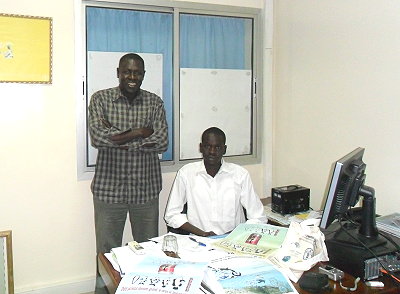
-
The collective experience will be written up by Mundus maris in June 2012 and validated by participants in view of reporting back results and an outlook to FAO's EAF Nansen Project.
Mundus maris will also encourage use of free web resources, which can be accessed via internet. Among these is the global web archive on all fishes - FishBase. A fish quizz and other apps will shortly be available via mobile phones, which are more widely distributed than internet-connected computers.
Mr Mane Jacques Diouf, a project agent in the FAO Office in Senegal is following the exercise to ensure good local connection between the FAO and the pilot activities. The photo shows Mr. Diouf in his office with some of the teaching aidswith local coordinator Aliou Sall looking on.

Workshop at the FAO in Rome
Upon the invitation of the FAO and its EAF Nansen Project, a workshop was convened in FAO HQ in Rome on 2 April 2012 to assess the state of play of the pilot activities to be implemented by Mundus maris in order to promote the ecosystem approach to fisheries in participating primary and secondary schools in Senegal and Gambia.
The workshop started with an overview presentation of Dr. Kwame Koranteng, EAF Nansen Project Coordinator, who updated participants on the objectives and achievements of the Nansen Project and highlighted in particular how the ecosystem approach to fisheries has grown from a more ecologically oriented concept into a holistic approach to fisheries management. EAF in short strives to integrate marine ecosystem understanding with social, economic and governance dimensions of human interaction with ecosystems. An FAO publication provided an excellent overview of different aspects of the concept and experiences with its implementation. Click here to get your copy.
Riccardo Del Castello is a communication specialist in the Research and Extension Branch (OEKR) of the FAO and in charge of overseeing the implementation steps of Mundus maris, particularly in relation to developing and testing a communication strategy and teaching aids. Riccardo recalled the terms of the letter of agreement (LoA) and summarised the framework within which the collaboration takes place.
Cornelia E Nauen was then invited to present the work carried out so far in implementing the LoA, which had entered into force on 21 July 2011.
Upon the start of the LoA research assistants and resource persons (school inspectors or headmasters of schools) were hired by Aliou Sall, the local coordinator of the pilot activities, in order to proceed without delay with a information and communication needs survey among schools in coastal and fishing villages in Senegal and Gambia as already outlined in the previous pages. Support for teachers on content, methodologies and visual teaching aids was a recurrent need identified. Blending of modern and traditional approaches to teaching taking into account the local culture appear most effective in meeting the identified needs.
Out of 35 schools participating in the survey work of the needs assessment, nine accepted to get involved in the pilot activities of advising on teaching aids and testing them to learn some lessons as to what are the most useful and effective approaches to promote the ecosystem approach to fisheries.
The pilot activities happen at an opportune moment, when IUCN's PREE project is supporting education ministries in the seven countries of the Sub-Regional Fisheries Commission (Mauritania, Senegal, Gambia, Cape Verde, Guinea Bissau, Guinea and Sierra Leone) at introducing environmental teaching into the ordinary curriculum. In this context, IUCN has developed the Knowledge Handbook on marine and coastal ecosystems in the region. The local partners of IUCN, e.g. in Senegal and Gambia, respectively UNI.V.ERE and Stay Green Foundation (SGF), collaborate also with Mundus maris in the FAO / EAF Nansen pilots.
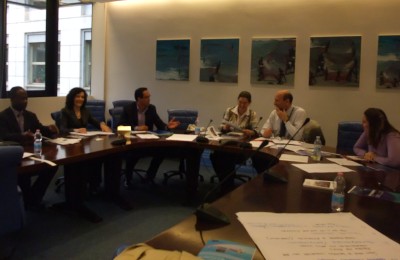
The materials in the teaching kit prepared in response to the identified needswere introduced at the first teacher workshop in Senegal, 17-18 February 2012. The teachers seized the opportunity to share their appreciation about them and already shared some initial comments for improvements. A coordinator in each of the two towns in Senegal took it upon himself to make sure the teachers and schools continue exchanging during the implementation of the test phase. They have meanwhile suggested a number of specific teaching modules followed by theatre plays to take the message of EAF and particularly of not fishing babyfish beyond the school, making use of the fish ruler.
The participants dedicated the whole of the afternoon to discussing about how to benefit the forthcoming teacher training workshop in the Gambia and enriching the teaching kit accordingly. Five key messages of the EAF approach are considered central for educational messages and adaptable for primary and secondary school situations:
- maintain ecosystem integrity (no fish is an island)
- precautionary approach to fisheries and other use of marine and coastal ecosystems and respecting the rules
- broad stakeholder participation
- promoting sectoral integration and safeguarding livelihoods
- investing in research and knowledge
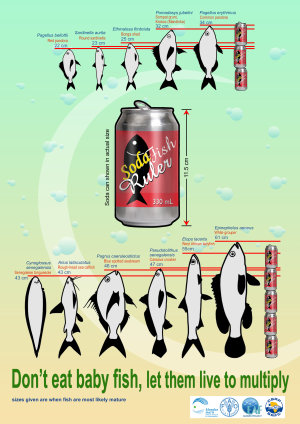 The teaching kit should then contain:
The teaching kit should then contain:
- guide for using the kit
materials, such as
- soda can fish ruler poster
- fishing down marine ecosystems poster
- fish ruler
- ecosystem poster
- EAF Nansen poster and flyer
- generic teaching materials
- monitoring and evaluation sheets
reference materials
- EAF Nansen leaflet
- IUCN Knowledge handbook about marine and coastal ecosystems
- Training manual of SGF
- Putting into practice the ecosystem approach to fisheries by FAO.
The implementation schedule has been updated for the remaining period for the pilot activities. The expected outcome is a robust appreciation as to which approaches and tools worked best alone or in combination and what can be further improved so as to explore opportunities for wider deployment.
Pedagogical ramble with the fish ruler and the soda can fish poster
by Abibou DIOP, Principal of the CEM Cayar
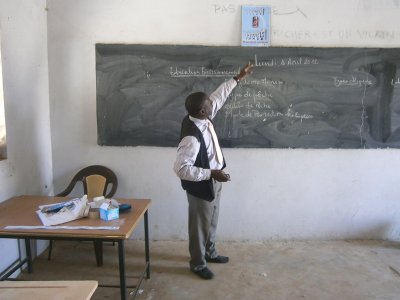
As part of its outreach and training activities for its members, all students of the CEM Cayar, the Mundus maris Club held its first art and education activity during the weekend of April 14th and April 16th. This consisted of a painting workshop programme supervised by the artistic director of the club, Ababacar Ndoye. A. Ndoye is a sculptor and painter, who has long supported the club.
The theme for this workshop was overfishing. A preliminary presentation was given by Mr Oumar GADIO, supervisor of the school, who had participated in the project seminar Mundus maris / FAO - EAF Nansen for the integration of education for environmental protection into the ordinary curriculum. More than 40 pupils attended the presentation, which also included a practical demonstration of the use of the fish ruler.
This ruler is a component of the educational kit, a set of inputs to currently being tested for their usefulness as teaching aids. It serves as support in education for the protection of the marine environment.
On Saturday, April 14, 2012 starting at 15h, the budding artists joined the Workshop of Painter Ababacar Ndoye Badou, who oversaw the first phase of the work of the troop of 8 girls and 12 boys. Each pupil sketched a picture on the theme of the day.

It was a real pleasure to ramble along the fishing pier for the use of the fish ruler and giving explanatory sessions on good fishing practices with emphasis on mature specimens fit for human consumption.
These were identified thanks to the measurements made with the fish ruler of length and width. Various species have been measured with the ruler and students were to assess certificates of cleanliness for the catches and and to determine whether they were fit for consumption according to the procedures established for the different species examined in the sample. The students held small meetings to explain to fishers, fish traders, vendors and conveyors.
The funniest moment was when a gentleman and a lady who, taking the young visitors to the fishing pier for people of great influence with the political authorities, were quick to ask that their complaints about the disappearance of the sardinellas they now buy expensively from Mauritania, are brought to attention of the President of the Republic or the Minister.

The little band took a pleasure from time to time to explain to people encountered on the fishing pier the importance of the fish ruler to certify the legality of the capture or not according to prescribed standards on the fish ruler.
The soda can fish poster with its slogan "Little fish becomes big if allowed to live" was also used by Mundus maris club members. This served as support for explanations to the public that seemed to fully appreciate our visit.
It is noteworthy that at the time of this activity, the fishermen in Cayar threaten to mount a punitive operation against fishing vessels that operate offshore.
The story of this educational ramble will be further illustrated by photographs taken on the occasion.
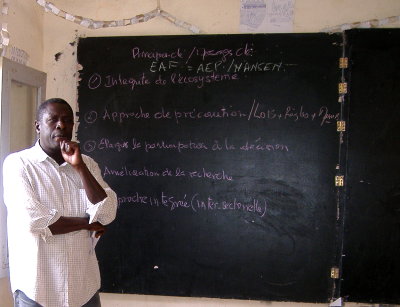
Meanwhile, additional follow-up work has been carried out together with the coordinator, Aliou Sall. In particular, an intermediary review has been carried out to see how the five key principles of the EAF Nansen approach have been reflected in the live tests in the school environment. They are:
- maintain ecosystem integrety (no fish is an island)
- precautionary approach to fisheries and other use of marine and coastal ecosystems and respecting the rules
- broad stakeholder participation
- promoting sectoral integration and safeguarding livelihoods
- investing in research and knowledge
These principles have been further articulated in the actual teaching modules in school.
Visualisation techniques have been used to support the understanding of the pupils. These have been reviewed during the follow-up session among the teachers and the coordinator and been further developed in a step-by-step manner.
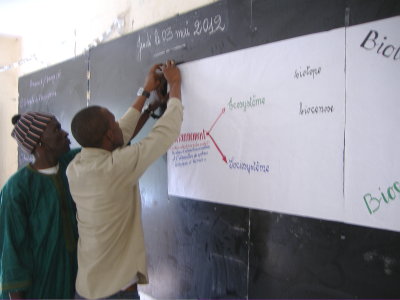 They also went hand-in-hand with consultations with external expertise, such as responsible persons from the fisheries research institute in Dakar, the manager of the marine protected area and others.
They also went hand-in-hand with consultations with external expertise, such as responsible persons from the fisheries research institute in Dakar, the manager of the marine protected area and others.
Exercises with the fish ruler were moreover a welcome opportunity to engage with local fish mongers and other professionals.
The conversations with old fishermen testified to the speed of environmental degradation in the last years and their negative effects on the social and economic conditions of the fishers.
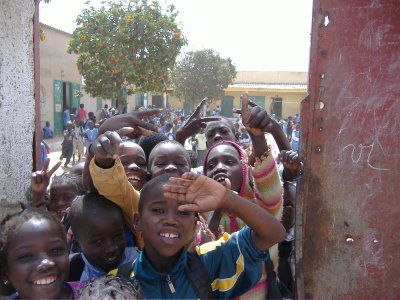 For the young kids - here a short during a break at school - this poses particular risk. Unlike in the past, the future for many may not be primarily in the fishery and the postharvest activities, but in other areas.
For the young kids - here a short during a break at school - this poses particular risk. Unlike in the past, the future for many may not be primarily in the fishery and the postharvest activities, but in other areas.
One hopes that the school and other learning opportunities offer them pathways to earn a place in adult life that is compatible with rebuilding degraded marine ecosystems and diversifying the economic activities - inside and outside a well-managed fishery.
Click here to see the testing programme in participating schools in Senegal.
Workshop highlights and results
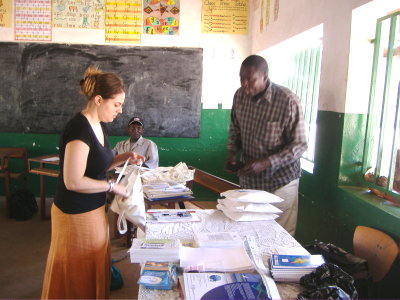
The workshop was held in Serrekunda from 28 to 29 February 2012 in Serrekunda Lower Basic School. It was attended by 8 teachers from the four following institutions: Gunjur Lower Basic School (2); Gunjur Upper Basic School (2) Immaculate Lower Basic School (2) and Tanji Lower Basic School (2). In addition to these four institutions involved from the initial phase needs assessment of the project, Serrekunda Lower Basic School was also represented by two teachers.
In addition to the teachers considered to be the main beneficiaries of this project, the following people participated: (i) the FAO Representative in The Gambia, Dr Babagana Ahmadu, was replaced in the occasion by Mr. Thomas Palma, who performed the official opening (ii) the National Director of Fisheries of The Gambia, Nfamara Dampha (iii) the Focal point of the Nansen Project in Gambia, Mr Ousman Job, (iv) the Representative of FAO Headquarters, Ms Silvia San Marco, (v) the Representative Mundus maris, who is at the same time project coordinator Gambia and Senegal, Mr Aliou Sall, and finally (vi) the two school inspectors, Messrs. Njayy and Kemo Jallow. The latter two were identified to assist teachers during the test and later deployment of the proposed teaching aids - once confirmed - in the official curriculum.

The seminar was held as planned, once the agenda was presented and accepted by all participants. To the delight of all participants, at the request of the headmaster of Serrekunda, who served as the host, they were treated to a surprise presentation of a sketch prepared by the pupils of school.
Following the official opening, objectives and expectations of the seminar were presented by the representative of Mundus maris, followed by the representative of FAO-Rome, who made the presentation of Nansen Project. The second presentation is crucial to the running of the seminar to the extent that some of this footage was devoted to the ecosystem approach to fisheries as conceived by the Nansen Project and its constituent "key principles".
Following this, Aliou Sall returned to present the various components of the teaching kit. There ensued a discussion between presenters and participants. The various interventions enabled the teachers to receive clarification from Mundus maris and FAO-Nansen on the support materials contained in the teaching kit.
 This first exchange in the form of questions and answers has also been interesting for collecting relevant comments from participants on the proposed teaching aids.
This first exchange in the form of questions and answers has also been interesting for collecting relevant comments from participants on the proposed teaching aids.
Among others, the teachers proposed improvements to the fish ruler for which they suggest that full colour photos of the fishes be used so that students can better identify them.
This suggestion was also made at the workshop in Senegal.
Similarly, the two posters contained in the kit were the subject of rich exchanges with teachers, who suggested slight changes in content in order to ensure their efficient use and later roll-out, when integrating the ecosystem approach to fisheries in the official curriculum.
 All contributions for an improvement teaching aids were taken into account by the expert team of representatives of the FAO-Nansen and Mundus maris. However, improvements could be considered definitive only after the final validation workshop, scheduled for in about a month, once the testing of these aids has been completed in real life situations, both in class and outside (see below actions planned for the test).
All contributions for an improvement teaching aids were taken into account by the expert team of representatives of the FAO-Nansen and Mundus maris. However, improvements could be considered definitive only after the final validation workshop, scheduled for in about a month, once the testing of these aids has been completed in real life situations, both in class and outside (see below actions planned for the test).
After this first day, used for updating participants on the Nansen approach and providing explanations concerning the content of the kit, the second day was devoted to working groups.
Both groups had received prior instructions, based on five key principles, which they assimilated very well in view of returning to the plenary with concrete proposals for specific messages and exercises to test both in the classroom and outside.
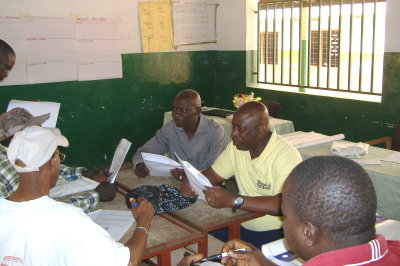 The two groups were moderated respectively by the representative of the FAO-Nansen and by the representative of Mundus maris. After much of the second day spent in interactive group work, participants met in plenary session with the following objectives (i) feed back the work of each group to the other and (ii) have the teachers concerned propose the exercises they intend to implement with their class in the test phase.
The two groups were moderated respectively by the representative of the FAO-Nansen and by the representative of Mundus maris. After much of the second day spent in interactive group work, participants met in plenary session with the following objectives (i) feed back the work of each group to the other and (ii) have the teachers concerned propose the exercises they intend to implement with their class in the test phase.
The actions planned at the community level involved in the project can be summarised broadly as follows:
Exercises in class
- Designs (Use your imagination)
- Posters
- Discussions with external stakeholders (fisheries experts and old fishermen)
- Story telling about fishing
- Songs
- Theater
- Reports on external observations (results of measurements and statistics collected)
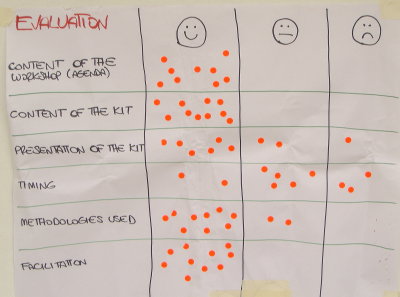 Exercises / observations outside class
Exercises / observations outside class
- Measurements (landing sites, export plants, local fish markets)
- Statistical data collections on fishing (landing sites, fisheries services, research center).
Comments and proposals for testing of the five key principles in the coming weeks were quite similar between the two working groups.
Click to see the overview of their programme:
Group 1 - Group 2.
Before concluding the workshop, all participants were invited to express their overall appreciation.
The distribution of voting points between the smilies suggests that the content of the workshop and teaching kit was unanimously appreciated and that participants approach the test phase in school on a high note.
Photos on this page by Aliou Sall, unless indicated otherwise.
Reviewing the first experiences
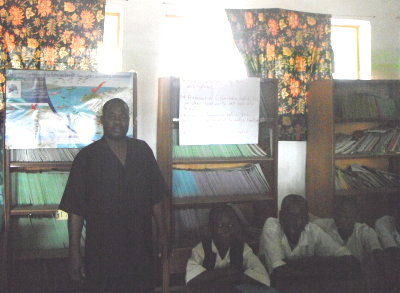
Stock taking of the first experiences with the use of the teaching kits took place in two workshops organised by Aliou Sall with all teachers.
The workshop in Hann, Senegal, took place 19-20 May gathering two teachers each from:
- the primary school Kayar 1,
- the mid-level school (CEM) in Kayar,
- the Khadim School, the primary school Montagne 1
- and the mid-level school (CEM)
The latter three in Hann.
The review workshop in Gambia took place in Serrekunda, 26-27 May 2012 with two school inspectors and two teachers from each school in attendance. They were from:
- Gunjur Lower Basic School,
- Gunjur Upper Basic School,
- Immaculate Lower Basic School Gunjur,
- Tanji Lower Basic School, and
- Serrekunda Lower Basic School respectively.
 In intensive discussions throughout the weekends the teachers went systematically through their experience in class and during excursions, discussing the teaching aids one by one. With small variations, the assessment converged considerably between the participants of the pilot activities. In summary, the teachers found that
In intensive discussions throughout the weekends the teachers went systematically through their experience in class and during excursions, discussing the teaching aids one by one. With small variations, the assessment converged considerably between the participants of the pilot activities. In summary, the teachers found that
- The guidance paper on methods and approaches was judged useful in structure in that it presented an explanation and background information to each of the five key principles of the ecosystem approach to fisheries followed by proposals for exercises in class and out of class. However, the teachers suggested to simplify the explanatory part and reduce the number of images, particularly those of a more conceptual nature.
- The poster of the EAF Nansen Project depicting two situations, an undesirable fisheries with destructive gear leading to social decline on the coast and an acceptable one showing prosperous coastal landscapes was unanimously accepted as a useful visual aid on a permanent basis.
- The fish rulers have been used to great effect triggering surprises and lots of fresh thinking among the pupils and the fish mongers at the landing sites or markets, however, as already signalled in the start up workshop, outline images should be replaced by full colour pictures to facilitate identification of the species. Scientific names were not deemed necessary for the final version of the fish rulers (see the test version for Senegal to the left).
- The teachers recommended to discontinue the use of the fish can poster - a variation on the fish ruler using a soda can for size comparison in case the more expensive fish rulers were unavailable. They argued that this would implicitly promote the use of unsustainable soft drink cans and thus risk to inadvertendly send the wrong message.
- The poster showing the key components of the Senegambian ecosystem was not sufficiently understood and requires a little more explanation. Rendering the fish species used on the fish ruler more visible in the final version will help increase the integration of the different teaching aids and strengthen mutually reinforcing use. It is also planned to extend that poster to a representation - before-after overfishing - so as to convey the degradation effect on the ecosystem more intuitively. The key message here needs to be that a well structured and functioning marine ecosystem is like a bank account. Most of the resource needs to stay in the sea to produce a steady high 'interest'.
Story telling and imaginary drawings have been used to good effect in application of the guidance notes. The teachers regretted, however, not to have had sufficient time to go deeper in exploring the use of the materials. In particular, several scripts for theatre and role plays had been developed but were not yet finalised, given the limited time slots available for carrying forward this extra-work. The general level of acceptance of the overall approach was high and the teachers engaged in detailed planning how to distribute suitable elements of the teaching messages and approaches across the syllabus in view of continuing the experience into 2013.
They unanimously requested to continue the collaboration and also work towards some additional equipment to bridge the digital divide and enhance the teaching environment for better learning outcomes for the kids.
Gunjur Lower Basic School and Gunjur Upper Basic School carry EAF-Nansen tests forward
Two schools in Gunjur teamed up to carry forward additional work using the teaching kit developed by Mundus maris in the context of the EAF-NANSEN pilot activities. At Gunjur Lower Basic School the teachers, Mr Baboucarr Jatta and Mr Malang Jabang, continued using the teaching kit during classrooms exercises and outside observation during June and partly in the first week of July. The same was done by Mr. Soulay Jobe and Mr Alaji Saine at Gunjur Upper Basic School. They implemented the action plan, adopted by all school teachers and inspectors at the validation workshop end May when assessing the initial test phase of the teaching kit.
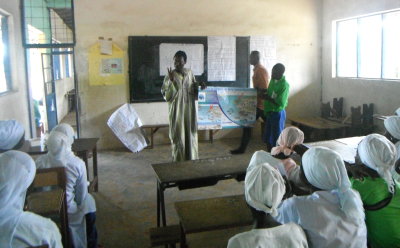
The exercises in classrooms consisted in
(i) imaginary drawings on the integrity of the ecosystem and the precautionary approach in the Arts and craft course;
(ii) commented texts and reports on the field trip and on the key principle regarding precautionary approach, both in the English course;
(iii) role plays in the frame of Social and Environmental Studies (SES).
During field trips, surveys are conducted, based on a questionnaire prepared by the teachers before immersions on the landing sites. The files used are processed by the pupils with the assistance of the teachers after the two field trips organised by the school.
Like in the other schools, the EAF-Nansen poster illustrating undesirable and acceptable fishing operations to illustrate five key principles of the ecosystem approach to fisheries, has been used regularly for exercises in class. Another poster specifically illustrating key components of the Senegambian marine ecosystem served to promote understanding of how marine species interact with one another and why it is important to keep the system in balance and avoid elimination of some species, e.g. by overfishing.
These two materials are considered as basic material utilised at least twice a week. The schools benefited from the active collaboration and support of Mr Alieu Touray, Manager of the Gunjur Community Fisheries Centre, Mr Janko Cessay, Principal Fisheries Assistant, and Mr Musupha Jassey from the Statistics Extension Cell from the Fisheries Department headquarters in Banjul.
The school inspector, Mr Jallow, came to Gunjur on 26th June 2012 for monitoring the experience. He spent the time between Gunjur and Tanji as the communities are close to one another. Mr. Jallow has given his impressions on the whole process in an interview.
 The field observations were made during two field trips for taking fish measures at the level of Gunjur landing site. Two sessions were also organised in the conference room of the Gunjur Community Fisheries Centre to listen to a lecture from fisheries scientists and fisheries officials, followed by a session of questions and answers with the pupils.
The field observations were made during two field trips for taking fish measures at the level of Gunjur landing site. Two sessions were also organised in the conference room of the Gunjur Community Fisheries Centre to listen to a lecture from fisheries scientists and fisheries officials, followed by a session of questions and answers with the pupils.
From a teacher's perspective, these interactions with pupils are very important, because they give the kids interesting inputs to engage in later classroom exercises, e.g. focused on the key principle “improve science”. The two schools have decided to organise jointly their field trips by renting two buses. This way, they got the collaboration from the resource persons of the fisheries administration.
As in the other schools, the field observations (measuring fish, compiling results of the surveys and interviews conducted by pupils with the stakeholders met on the trips) were valued and exploited once back in the classroom either for reporting or for commented texts. These exercises were also conducted and supervised by the fellow-teachers in the other participating schools either in the frame of SES or in English courses.
Serrekunda Lower Basic School activities in June and July 2012
by Bolong Touray and Lasana Touray
Serrekunda Lower Basic School has voluntarily participated in the pilot activities carried forward by Mundus maris commissioned by the EAF-Nansen / FAO. Following on from the action plan agreed among school during the review workshop end May, still before the end of the school year, we have implemented the following:
In class exercises
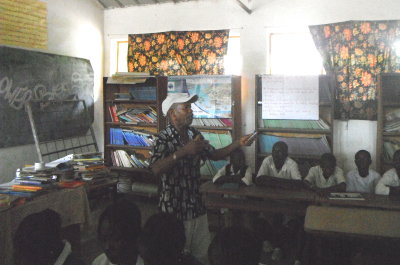 During the first week and the third week of June 2012, we have organised jointly exercises in the Serrekunda school library. The exercises are of several kinds
During the first week and the third week of June 2012, we have organised jointly exercises in the Serrekunda school library. The exercises are of several kinds
(i) imaginary drawings on the integrity of the ecosystem and the precautionary approach in the Arts and craft course;
(ii) commented texts and reports on field trips and on the key principle regarding the precautionary approach in the English course;
(iii) a couple of questions and answer sessions between the teachers and the pupils using the two posters of the teaching kit (see various photos regarding exercise in Serrekunda lower basic school).
 A piece of drama that was first performed by the pupils during the validation workshop has been improved and finalised, before it is going to be presented to a wider public from the school community of more than 4000 pupils at the end of July.
A piece of drama that was first performed by the pupils during the validation workshop has been improved and finalised, before it is going to be presented to a wider public from the school community of more than 4000 pupils at the end of July.
We have developed a stock of materials available with the master teacher such as: files used for surveys during outside observations, drawings, reports done by the pupils giving their impressions after the field trip.
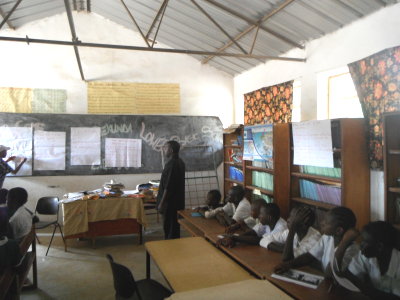
During all June, we did our best in order to ensure that all the pupils have clearly understood the five key principles about the ecosystem approach to fisheries and can make a good interpretation of the EAF-Nansen poster.
Within the SES course, the pupils were thus invited to come to the board and demonstrate what they had learnt.
This approach is lively and dynamic and considered by pupils an opportunity to escape from exam stress.
The first and second weeks of July were chosen by the school inspectors to establish a first global assessment on the process and the achievements.
The inspectors wanted to monitor the process prior to the closure of schools before the end of July. It is important for the inspector to develop his own evaluation of the pilot activities, so as to communicate them to the Ministry of Education for the annual assessment given to each school.
In this context, the participation in the pilots is considered an important added value for schools (see the inspector interview).
Field observations
Brufut has lost its former role in the fisheries as a result of an impressive and fast urbanisation process (hostels and residences occupying gradually the seaside). Given the long distance from Serrekunda to Tanji and Gunjur, Serrekunda Lower Basic School’s field observations were organised in Serrekunda and Bakau local markets. We also facilitated discussions between teachers and pupils and scientists coming from the Fisheries Department headquarters in Banjul.
Given our travel constraints, we end always with exercises in classrooms. In fact, beside the two posters provided in the teaching kit, the main source of inspiration for exercises are the data collected in the excursions and from the fisheries administration agents/ officials and the stakeholders, using also the fish rulers (see model to the left).
During his last monitoring mission in The Gambia, the coordinator has met Mr Jallow, Gambian school inspector in charge of monitoring the pilot activities. Aliou Sall wanted to collect Mr. Jallow's assessment about how the participating schools have carried out the exercises so far, now that the academic year is about to be closed the third week of July. Mr Jallow’s appreciations were recorded through the interview below.
MM-Q: Mr. Jallow, since the starting of the tests of the teaching kit in the context of the FAO - EAF-Nansen Project, meaning since the first seminar 28-29 April 2012, you are closely following the implementation. After the second workshop, held in Serrekunda School for the validation of various tools provided by the project, I come back to The Gambia in order to collect additional feedback concerning the implementing of the pilot phase. I have already exchanged with the teachers of the various schools involved. Now, given your role as an inspector assigned to monitor the process, I would like to have your point of view concerning the significance and achievement of the initiative.

A: The project brought us, generally speaking, an important added value for the syllabus and in particular for the SES subject [SES = social and environmental studies]. In fact, as many of our pupils are coming from fishing communities (if we take into account those from Gunjur and Tanji), we are supposed to be concerned by issues related to marine and coastal resources. Issues related to marine and coastal resources should be targeted in the frame of courses such as SES and science.
In fact, SES has a general core. Based on this first appreciation, we can say that the project is timely. The teachers and thus the pupils consume fish on a daily basis, but were not aware about the issues regarding the marine ecosystem nowadays. This is noteworthy in particular for those coming from Gunjur and Tanji, where fisheries and farming are the base for livelihood. Myself, as a Gambian, I eat fish every day, but I didn’t pay attention to the variety of species and their different names. Something we find too amazing is that, before starting this project, the large majority of teachers and pupils from Gunjur and Tanji had never been at the landing sites for the purpose of measuring fish and for interacting with the Fisheries Department agents and scientists.
MM-Q: In case, you had the opportunity to attend some ongoing exercises in the frame of your various monitoring missions, how did you appreciate the teachers’ commitment?
A: Because, the project is bringing us a concept and tools on issues that are our concerns – as part of fishing communities and/or as consumers - you can understand why teachers, pupils and even the Department of Education is enthusiastic to welcome this project. It was no problem to implement it in The Gambia, because of the existence of the SES, as part of our syllabus.
It is really an important added value for us to apply the SES concept in the marine ecosystem area. I am really impressed by the way the pupils are all committed during exercises in class and by outside observations. If we had the required means, all the pupils would like to participate in the outside observations. But it is already a good start to have some groups in the process. I hope it will be widened to other groups. The groups I saw at certain working sessions are impressing by their dynamism. The Department of Education appreciates the initiative because the Gambian government has given priority to environmental issues in the curriculum.

MM-Q: As the executing agency for FAO - EAF-Nansen Project in this context, Mundus maris is honoured to learn that this project is of interest for the Gambian education programme. But beyond these interesting achievements, may we know what limitations and constraints you identified within the implementation of this phase from your perspective as an inspector in charge of the monitoring on behalf the Education Department, and what are the perspectives for future?
A: The major constraints I noticed and that we have to overcome, if we want to achieve the expected outcomes, are of three types.
First of all, there was limited time available for the tests before the end of the academic year. At the same time, teachers had to make arrangements with their full agenda with the exams that take place between the first and the third week of July. So it was tough for them, but I realize they did a good job, despite time constraints.
Secondly, many exercises were not fully documented because of the lack of audio visual equipments at the right time. I am sure that if all teachers were equipped by digital cameras (at least) the FAO-EAF Nansen Project organisers would appreciate even better the efforts provided between June and July after the initial test phase. I hope that in future and before the next academic year, we will succeed in getting some equipment, at least one digital camera per school and for the inspectors, as far as the activities to be imagined as a longer term process. In fact, the EAF-Nansen principles have to be integrated and practiced for ever in the curriculum.
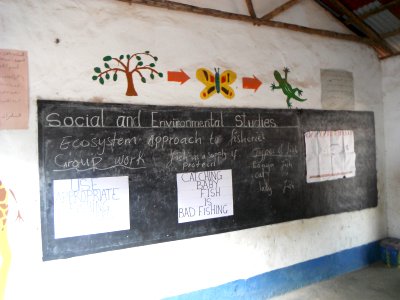 The third type of constraints are related to the mobility that is not always evident when it’s time to go to the field for outside observations. We appreciate all kind of support provided by the project in order to enable the holding of the two seminars and the organizing of field trips but it should be important that we obtain a supporting fund in order to start exercises early at the start of the next academic year and have the possibility to have a seminar after one academic year to have an internal evaluation for the use of the Department, because we have the ambition to extend this experience to other schools of The Gambia.
The third type of constraints are related to the mobility that is not always evident when it’s time to go to the field for outside observations. We appreciate all kind of support provided by the project in order to enable the holding of the two seminars and the organizing of field trips but it should be important that we obtain a supporting fund in order to start exercises early at the start of the next academic year and have the possibility to have a seminar after one academic year to have an internal evaluation for the use of the Department, because we have the ambition to extend this experience to other schools of The Gambia.
Finally, there is an important and worrying issue which we need to work on. This concerns the electricity problem. Besides Serrekunda Lower Basic School, none of the schools involved in the project has electricity supplies. Gunjur Lower Basic School had a solar panel that broke down and may be repaired soon.
So, as far as The Gambia alone is concerned, may be the teachers and the pupils will manage with this lack of electricity. But, if the project is intending to develop collaboration and synergy with the Gambian schools and offer better access to additional web-based resources, it will be important to think together how to supply solar panels to schools, even if it’s just for the purpose of good communication by internet between the schools and the project based in Europe at the FAO. In my mind, we have to be make some efforts in this direction. I am convinced we must work out a strategy to equip these schools with solar panels, as least for the running of one computer in each of the participating school. Why not, trying to mobilize funding agencies in Banjul with the help of EAF Nansen-Mundus maris project?
MM: Mr. Jallow, thank you for sharing this assessment with us.
The assessment of the experiences between June and July 2012 was made with the Director of the primary school Kayar 1, Mr. Ndiaye, during two missions of the project coordinator, Aliou Sall, in July 2012. Mr. Ndiaye is also one of the teachers participating actively in the pilot activities. Exchanges between the school principal and the coordinator produced the following highlights:
I. Approach and strategy chosen
There is a peculiarity of the school Kayar 1 regarding the approach to the implementation of the pilot activities.
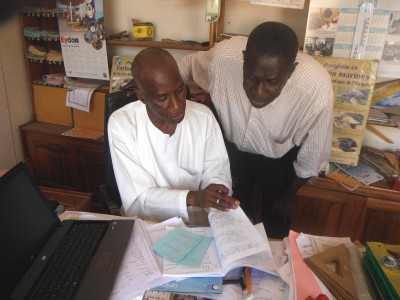
While in other schools - both in Gambia and Senegal - only two experimental classes from each participating school are fully engaged in the exercises, the school principal of Kayar 1, working with his staff and parents, took the initiative to expand the ecosystem approach to fisheries (EAF) according to the EAF-Nansen project at all levels, namely the CI to CM2. So, the exercises (some extended until about August 4, 2012) covered all classes. Moreover, a total of five more teachers have been involved in addition to Mr Ndiaye. Each of the teaching staff has been assigned one of the five key principles. The other five teachers are Mr. Samba BA (for ecosystem integrity), Mr. Aliou FALL (improving research), Mr. Saliou SOW (precautionary approach), Mr. Samba FAYE (widening participation) and Mrs. Moussou DEMBÉLÉ (multi-sectoral approach). We note in passing that the school principal, along with one of two school teachers involved in the project, has extensive experience with the programmes (of international NGOs and public institutions) about the awareness on environmental issues.
Social mobilisation is considered by the primary school of Kayar 1 as a prerequisite for project success. Indeed, according to the director, the successful pilot phase is due to the active collaboration of social actors whenever they are requested. The mobilisation of these social actors - apart from officials and employees of the fisheries administration on site - owes its success to the approach taken by the teaching staff. They had identified three vector of people who werer not only expected to 'own' the project, but also carry its message as opinion leaders into the community. To achieve this, the teaching team relied on three groups, called the three hearings, namely: (i) those who have no idea about the concept of environment and its reality, much less focused on the EAF and marine ecosystems, (ii) those who are relatively well-informed, and finally (iii) the audience of customary chiefs and delegates from districts who have traditionally played an important role in social mediation.
II. The activities and actual achievements
a. Classroom exercises
Each class is subdivided into five working groups for the purposes of the exercises. This approach is maintained even for external observations. The exercises focused on five "key principles" in the following courses:
Drawing: A few pieces of pencil drawings called "argumentative design" has been made, with great emphasis to the key principle "Ecosystem Integrity." The message on which the pupils worked as follows: "Destroying the sea, is to commit ecological genocide".
French: During the credit hours for French, the students created poems on the five key principles, in the part of the course called "Written expression". The idea is to make a collection of poems, once that a sufficient number would be selected.
Performing arts: Several auditions are still ongoing. However, the school has already produced a sketch that was inspired by the two posters provided by the project (project EAF-Nansen poster and the poster on the Senegambian ecosystem). For the record: The Senegalese side did not have the full guideline and EAF-Nansen displays in time for the start-up workshop. But when these elements were available - in English for the Gambia - the project coordinator has taken the initiative to help the Senegalese teachers to take ownership of these basic and important elements of the teaching kit to fill the gap between the two countries. He visited all schools organising catch-up sessions during the month of April. Also, he relied on two teachers from both mid-level schools (Messrs. DIOP based in Kayar and SARR in Hann, who have a good level of English and who have continued to provide support at the request of other teachers).
The sketch was so interesting that a local community television channel called Channel 8 Kayar was filmed the performance (copy of this sketch will be negotiated with the director for reporting purposes). In addition to this sketch, the pupils have produced another whose cast covers three sequences: (i) What is the marine environment?; (ii) What is the difference between a healthy and a sick environment?; (iii) What new vision and approach towards the environment?
For lack of appropriate audio-visual media, some pupils took a few scenes with mobile phones, but these have limitations in terms of both storage capacity and mage quality. The headmaster has promised to the coordinator at the latter's last visit to the site, to recover the maximum of images of the pupils for an aggregate presentation and higher recognition for their work.
Hearing: One of the most interesting and innovative initiatives undertaken in the pilot activities was to hold a hearing within the school for which the teaching team had invited some fishermen from the community of Kayar known for their solid grasp of the main vicissitudes experienced by the marine environment in recent years. Aged around 55 to 60 years, these fishermen came to testify to the young people on the rapid degradation of ecosystems, which they have observed throughout the years. Having entered the fishery very young (from the age of12 years or even less in some families, to at most 15 years) their rich experience accumulated over time allowed them to give a comparative picture of the situation from the 1970s to our days. In addition to the degradation of marine resources in general, they commented on some emblematic species that either have become rare or disappeared completely. This kind of conference was a first opportunity given to persons of a certain age to talk to their grandchildren (pictures taken with whatever means will be collected for reporting purposes).

It was an opportunity for the awakening of a collective memory in favour of an awareness of the younger generation. Mr Ndiaye explains the context within which the school works: "While environmental education is encouraged and decided by public authorities, we do not have a precisely defined and formal programme. We have a favourable receptacle and we must create the programme based on our own initiative and according to the tools we find. The tools at our disposal through the EAF-Nansen are therefore timely and represent an important added value for us. Currently, as a pilot school are also benefiting from a pilot project implemented by the Republic of Korea (Sankore Project). I have no problem since I can progressively integrate the tools provided by the NANSEN project into the software provided by the project."
On the methodological approach to the exercises, this is the process used by the school principal:
-
External observations by students after preparation by the teachers, this phase of the first immersion is the opportunity for the young pupils to ask questions and begin to make assumptions;
-
Back in class the teacher helps to formulate the pupil's thoughts, because they still have their limits;
-
Thereafter follows the classification phase through which the teacher helps the pupils organize and analyse their thoughts.
-
This amounts in other words to the following process: make an experience, classification of ideas, theory formation, synthesis and evaluation, which should result in proposed solutions. So, in the end - for every problem or issue posed – it's a matter of helping the pupils identify the problem, define the causes and propose solutions. According to Mr Ndiaye, this process should be visible in detail through the exercises, whether they are drawings, sketches, texts or other commentary. These are achievements of the pupils, which can attest to whether or not they have acquired complete ownership of key principles and the messages resulting from they.
b. The external observations
On exercises outside the classroom, the main strengths to remember are as follows:
Preparation Phase: Teachers prepare the ground by making the necessary contacts with those to be visited. The posters are very useful tools for preparing the observations, which are in the time slot entitled "field trip".
Tools: The tools of data collection are various: the fishruler, questionnaire surveys, interviews and recorder. In some cases, for the shooting, use the services of a paid photographer or videographer.
Profiles of those met: Management Team of the Marine Protected Area (MPA) Kayar, officers of the Departmental Fisheries Service Kayar, representatives of fishermen's association and active fishmongers, met at Pencs and shelters of old retired fishermen.
III. Constraints and prospects for an improved learning environment
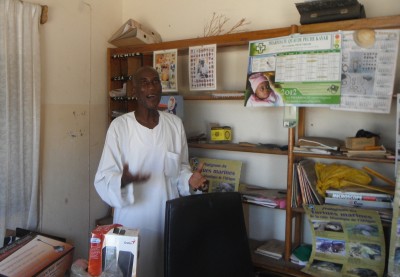
With all the opportunities provided by the introduction of the EAF in the curriculum, the team of Kayar 1 identified a number of constraints of different nature, which delayed the implementation of the pilot phase, as it would have wished, namely:
Administrative and socio-political conditions: Senegal has just emerged from a paralysis of the school system, which lasted almost seven months. There will thus be no school holidays for pupils and teachers of the secondary cycle. This crisis has not spared the primary cycle. The planned exercises have been limited, given the fact that to save the year, schools had to offer remedial courses for pupils. which does not give enough time to run the whole schedule of the first phase.
Logistics: The initiative of the Senegalese-Korean cooperation will enable a more efficient use of tools and media (audio, writings made available by the project EAF-NANSEN). However, teachers remain convinced that they must work - even approaching the Korean cooperation and other cooperation actors - to equip themselves with good digital camera, in the absence of a video camera to document the exercises all the time. The teachers regretted not to have a camera at their disposal so far. They have also raised the need to develop a corner of their library with documentation (including virtual media) devoted to the theme of marine ecosystems and on-going initiatives to restore them, such the EAF-NANSEN pilots.
In addition, anxious to ensure benefits for the pupils and especially in order to show them they did useful work, the teachers agreed to leverage the work of these young people. They conduct the following activities: (i) collecting best argumentative drawings made during the year and organise an inter-class competition. The selected designs will be collected in a document as a basis for the library; (ii) Collection of best poems for the library; (iii) Gradual establishment of a gallery to be fueled by the photos taken during exercises. The aim is to gradually build a database and supports, which could be a traveling exhibition through other schools. They could also be exposed during major events, such as World Oceans Day on 8 June each year.
The ecosystem approach to fisheries (EAF): A pathway required for the preservation of the marine ecosystem
according to Magueth Diop, Director of the Khadim School
As part of the monitoring activities of the pilot project FAO – EAF-Nansen, Aliou Sall collected the views of Mr. Diop Magueth in July 2012, just like with other schools in The Gambia and Senegal. Mr. Diop is the director of the Khadim School in Hann and actively involved in the tests to integrate the ecosystem approach to fisheries (EAF) in the school curriculum. He gives us his impressions through the interview below:
MM-Q: Mr. Diop, what represents EAF in environmental education work, which you have begun to practice in recent years in ordre to raise awareness about this dimension through your programme?
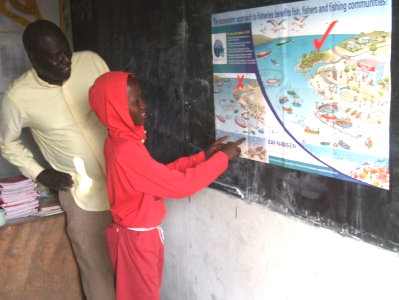 A: No doubt, the ecosystem approach is an effective way to inform and educate pupils, the commununities and the public authorities on the protection of the seas and oceans. It is for us a mandatory way to preserve the marine ecosystem. The five principles have their own importance. That said, the key principle on the ecosystem integrity that must be preserved, has had a great and unexpected effect for us teachers and students. We are all from a community of fishermen and so we began to consider the Hann Bay, having regard to the degree of pollution, as a sick neighbour. This notion has also been integrated in the sketch, which we introduced in the competition of the departmental schools and for which we won a trophy.
A: No doubt, the ecosystem approach is an effective way to inform and educate pupils, the commununities and the public authorities on the protection of the seas and oceans. It is for us a mandatory way to preserve the marine ecosystem. The five principles have their own importance. That said, the key principle on the ecosystem integrity that must be preserved, has had a great and unexpected effect for us teachers and students. We are all from a community of fishermen and so we began to consider the Hann Bay, having regard to the degree of pollution, as a sick neighbour. This notion has also been integrated in the sketch, which we introduced in the competition of the departmental schools and for which we won a trophy.
Even if we stopped here, we think it is an important achievement. Indeed, this project, with the tools at our disposal – including the two posters that helped us a lot in our different work lines with the pupils - led to advocacy work even outside the context of our community. Even more, it also helped create collective awareness during the presentation of the sketch in three different places, like the realisation that the sea is not only made up of water. We should appreciate the fact that the sea is made only of water for people who did not have the opportunity to discover the diversity of fauna and flora that live there.
MM-Q: Is there other impacts recorded among pupils who participated last few months in this work?
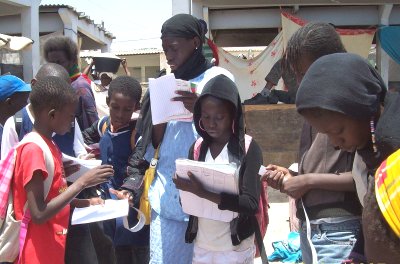
A: You know, the application of such an approach allows to highlight the most intimate relationships between men and marine ecosystems. Through our experience in the Khadim School and the fishing communities in Hann who now consider Hann Bay and its waters as severely ill neighbours, we perceive in each other this fierce determination to spare no effort to heal them.
MM-Q: We know that for a few years, compared to other teachers, you have stood out for the priority you gave to traditional theater for environmental education. May we know what the EAF meant for you in this specific area?
A: At the pupils level, the ecosystem approach has significantly contributed to enhancing their artistic and oral expression enriching their vocabulary. It also sharpens their intellectual curiosity and prepares them to become future ambassadors of the marine ecosystem and especially fishermen. Ecosystem approaches are also reflected in the development of a sense of the whole and every integrating sustainable development concepts (conservation and protection of marine fry).
MM-Q: Do you want to add anything else?
A: Well, I can say that the tools provided by the project, as a rule, have allowed pupils to acquire skills that will continue to grow through the science and observation lessons, while helping to enrich their vocabulary, based on new scientific concepts, hitherto reserved for an elite of researchers. We are in a real process of popularisation of science tools regarding oceanography in general and fisheries in particular. Also, the budding collaboration between schoolchildren, fisheries managers and scientists thanks to the field trips is one of prerequisites for concrete synergies. These should result in multifaceted actions likely to love, respect and above all protect the seas and oceans, which traditionally provide invaluable food for all the inhabitants of the planet Earth, including the future generations. The role of procurement of such goods must be preserved by a responsible and sustainable management of ecosystem integrity.
MM-Q: Have you noticed a few problems, minor or major in nature, which may be some constraints in your efforts to incorporate the EAF permanently in your curriculum?
A: There have been problems as a result of the school crisis, which meant that we did not have enough time to devote to both testing the kit and then its full implementation. Otherwise, there would have been more results and products (especially the form of sketches) that our European partners could promote on their websites or online journals. But we will relaunch next school opening.
There's also another kind of logistical problem. Today, our schools are poor and this is reflected in the lack of even a minimum access to informatics tools on a more or less regular basis. Access to ICTs is also considerable support to enable our pupils to build networks with schools in Europe, particularly French-speaking ones. Finally, I also hope that the nascent network of schools participating in the project may be accompanied during the next 18 months, in order to establish a solid network that could stand on its own feet in 24 months. But this requires the facilitation of periodic capitalisation meetings during the phase of 18 months, which we planned for as the pilot phase.
MM: Thank you, Mr. Diop
Achievements, problems and prospects of the pilot phase
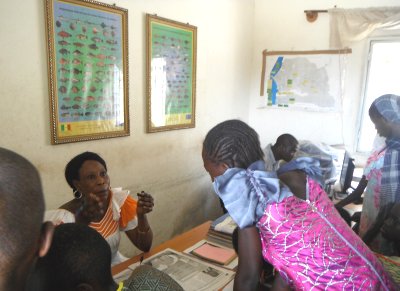
Like other institutions involved in the project, the Mountain 1 School in Hann carried out activities both in class and during field trips. The school preferred to spend the limited time before the school holidays for preparatory exercises during the following subjects: observational sciences, French and awakening, as well as during field trips. In fact, the teacher leading the project within this institution, Mr. Mamadou Ndiaye, together with the second teacher, Mr. Ndiaye Sall, prefers to wait for the resumption of classes in September-October 2012, to develop a theatre piece. They intend to integrate the five key principles of the ecosystem approach to fisheries (EAF) in this piece. They are indeed inspired by the experience of the Khadim School, which has keenly exploited the five key principles in a sketch, which made them win the school theatre contest of the Academic Department in Dakar.
The teachers at this institution took an innovative initiative before entering the exercises themselves. They collected data from various departments of the municipality to make a presentation of the various activities that support the municipal budget and thereby enable students to appreciate the importance of fishing for local development. Regarding the exercises themselves, they focused on (i) pencil drawings, (ii) reports on observation and (iii) the argumentative texts in French lessons. All exercises were performed according to a three-step process.
In-class exercises and outside observations
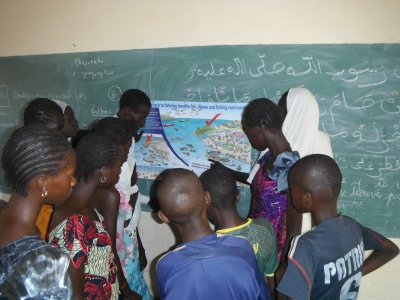
In a first step, the preparation consisted of recalling the five key principles of the EAF in class by the two teachers.
Pupils were then invited in turns to come to be blackboard to show that they had well understood the content of the posters: the EAF Nansen poster confronting two situations, one of fisheries using the ecosystem approach and another, where the approach is not complied with and the other poster showing the Senegambian ecosystem.
The programme preparations included for pupils to respond to questions the teachers had prepared in advance.
Then, in the context of time allotments available for field trips, the teachers made three excursions to visit and interact with the following players: Department of Fisheries and various associations of fishermen and fishmongers at the landing site in Hann.
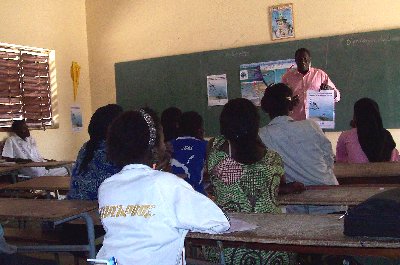
Finally, after these preparatory steps the teachers adjusted additional classroom exercises creatively to time slots allocated to different subjects: Argumentative texts in French lessons; drawings and reports by students on the basis of observations made at the end of the field visits, for example during a reporting session on the beach.
For class work, the Mountain 1 School focused on the three from among the five key principles of the EAF, namely ecosystem integrity, the precautionary approach and improving research. They focused on drawings relating to ecosystem integrity and fish measurements complemented by reports of pupils, who found a widespread disregard of minimum size limits. In addition, they worked on the problem through texts discussed in the context of French lessons and writing within the observational sciences.
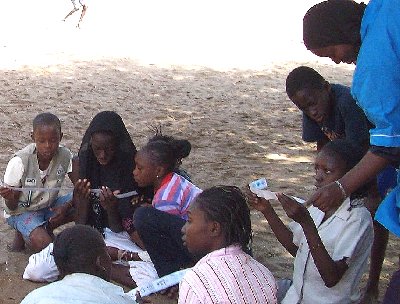
Regarding science observations, the teachers at the Mountain 1 School gave great importance to the initiation of pupils in the biology and ecology of the main fish species caught and sold in Senegal, describing also the fish ruler.
Mr. Mamadou Ndiaye, lead teacher responsible for the project, looked after the preparations by setting up the necessary contacts with the Department of Fisheries, members of the inter-professional GIE (Economic Interest Grouping) associations responsible for the exploitation of the wharf Hann and with the laboratory technicians in charge of quality control at the same landing site in Hann. It should be noted that all of these have spared no effort to help the success of field trips. The fisheries officers demonstrated unfailiing availability.
Among the activities carried out effectively during these field observations, there were (i) fish measurements, (ii) exchange sessions between pupils and staff at the Department of Fisheries in Hann, namely the person in charge of statistics, and (iii) a meeting with the associations of fishermen and fishmongers.
The constraints and opportunities

The main constraints according to Mr. Mamadou Ndiaye are: First, he deplores the short time available for the project. Time would have been sufficient under normal conditions, but with the school crisis in Senegal from October 2011 to February 2012, teachers were often obliged to organize remedial courses to reach the end of the original programme in the official curriculum. They want to invest very early in the opening of the new school year for the implementation of planned activities in their action plan.
Second, it must be negotiated with the Ministry of Education in a formalised manner to integrate the principles of the EAF in the curriculum. While the teachers can continue to do this work, which can only be appreciated by the public authorities, in an ad hoc way, but a formalization would be better. This could be done, according to Mr. Ndiaye, by a meeting between teachers in the network between Hann and Kayar one hand and authorities representing the Ministry of Education.
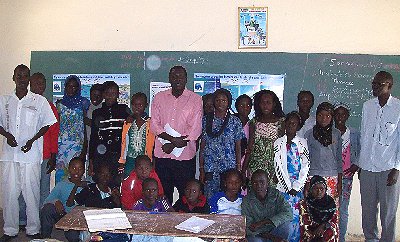
Third, he recognizes and appreciates the fact that the project has created the conditions to meet (held workshops) and assist in the implementation of classroom exercises and external observations. However, to perform all the actions included in the action plan, it will be necessary to find additional support in a context, where schools lack everything. These are real needs that require funding to support ongoing and / or planned initiatives, not budgeted anywhere. Support is required not only for stationery and photocopying, but also for a minimum of computer equipment.
Mr. Ndiaye: "We are in a school, where there is not a single computer, let alone talking about internet access for our pupils and ourselves as teachers. With the socio-cultural Centre, our pupils and ourselves had the opportunity to access the internet for a symbolic contribution, but for a long time now, this communcal cyber café is closed. We need to travel almost 3 or 4 km to find a cyber café, but the nearest ones are promiscuous and have slow connections due to the obsolescence of equipment they use. Access to minimum computer facilities is a prerequisite if we are to succeed in this project. With my fellow teachers, we must see how to address this challenge.”
Note:
Sometimes a pdf file cannot be opened in your browser, depending from your programme, configuration, plugins. In any case it is always possible to save or download it, to be opened locally.
Good practice in teaching: The phases of the evaluation process
Teacher handbook Methods and approaches to teach the ecosystem approach to fisheries (English)
Poster of the Senegambian ecosystem: big (A1), small (A4)
Fish ruler for Senegal (french)
Monitoring and evaluation sheet for teacher satisfaction
Monitoring and evaluation sheet for learning assessment of pupils
Monitoring and evaluation sheet for school inspectors
Additional resources:
FAO, 2005. Putting in practice the ecosystem approach to fisheries. Rome, FAO
EAF-Nansen Project flyer: The Fisheries Manager and the ecosystem approach to fisheries
EAF-Nansen Project brochure: Strengthening the knowledge base for and implementing an ecosystem approach to marine fisheries in developing countries
IUCN "Knowledge Handbook - Discovering the marine and coastal environment in West Africa" prepared in the context of the Regional Environment Education Programme (PREE)
European Commission, 2005. Rebuilding our Marine Ecosystems, Protecting our Future. Brochure on Key Findings of the International Symposium on Marine Fisheries, Ecosystems and Societies in West Africa: Half a Century of Change. Dakar, Senegal, 24-28 June 2002. 24 pages.
FishBase, the global encyclopedia on all fishes (can be searched also with local names in different languages and with many other search criteria. It also offers fish identification, quizz, and much more)
SeaLifeBase, the global encyclopedia on non-fish marine organisms (can be searched similarly to FishBase)
Teaching guide about biodiversity - Grades 4 to 6: What is biodiversity?
Sea Around Us Project documenting the impact of fisheries on the oceans around the globe.
A new website offers analytical information through the health of the ocean index. The index treats people and nature as integrated parts of the whole. The ecosystem approach to fisheries (EAF): A pathway required for the preservation of the marine ecosystem according to Magueth Diop, Director of the Khadim School



















